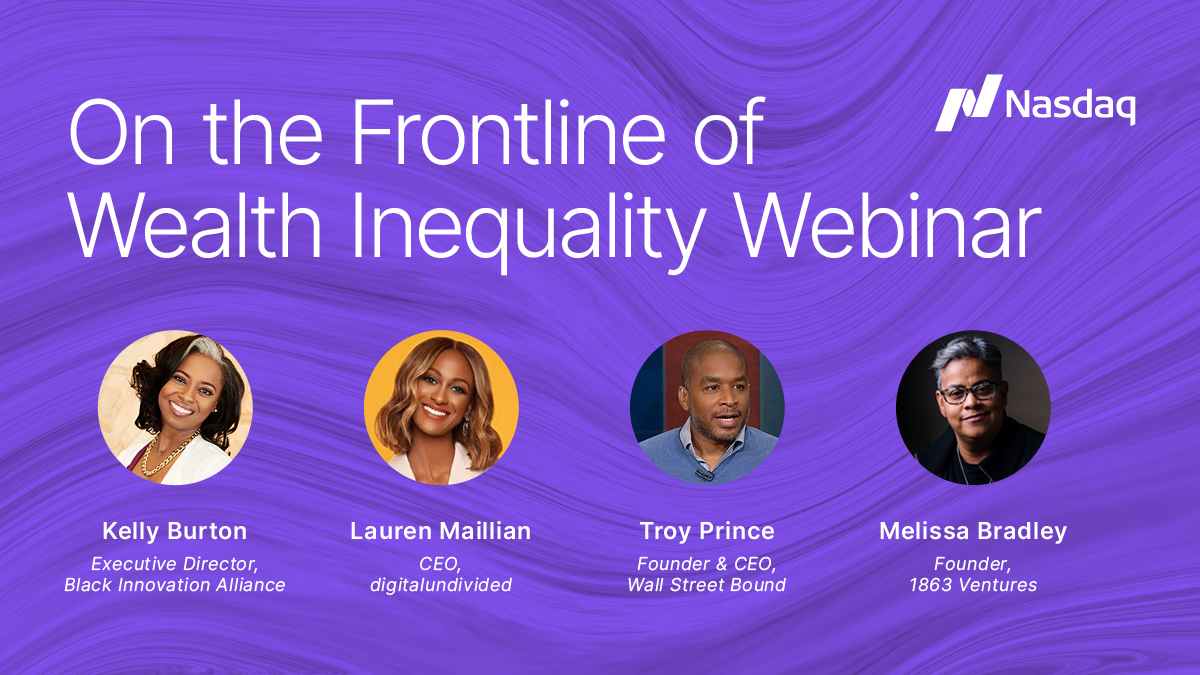Addressing wealth inequality is one of the most critical issues we face today. While there is no silver bullet that can reverse generations of imbalanced opportunities in a matter of months, understanding the implications of race in our society, particularly as it relates to the capital markets, is pivotal to creating systemic changes that will support and empower communities of color. As part of our ongoing efforts to advance inclusive growth and prosperity, Nasdaq recently hosted a virtual panel discussion, “On the Frontlines of Wealth Inequality,” for our inaugural Purpose Week, during which esteemed experts discussed critical actions that we can take today to address wealth inequality—from exposing under-represented communities to financial literacy to supporting diverse entrepreneurs.
Hosted by Nasdaq Chief Strategy Officer Jeremy Skule, the panel explored processes for creating fairer and more prosperous markets and how each of us can play a role in creating a better future. Panelists, including Digitalundivided CEO Lauren Maillian, 1863 Ventures Founder Melissa Bradley, Wall Street Bound Founder and CEO Troy Prince and Black Innovation Alliance Executive Director Kelly Burton, shared their insights and firsthand experience about what works to alleviate the wealth inequality gap.
“It is going to take changes in the market. It’s going to take changes in education because of the generational depression, marginalization, exclusion; there’s no one lever that we can pull that this is all over,” said Bradley. “So, if I were to say what are three things that people can do: start within, start within your community and then scale.”
To look within, Bradley emphasized that leaders should evaluate whether a company’s policies and practices support racial equity. As Prince noted, a 2020 McKinsey study found that companies in the top quartile for gender diversity on executive teams were 25% more likely to have above-average profitability. Considering this evidence, Prince urged companies to provide internships and job opportunities for younger people of color.
“If you want to see inclusive growth, you have to create an inclusive organization,” Burton added.
Business leaders can then build upon their internal diversity efforts, thinking about how they can democratize access to wealth-building strategies through programs and vehicles that encourage investing within their communities. These programs could include financial literacy coursework in high school and, more broadly, exposure to the stock market through classes or competitions.
“By far, most [people within] our community do not grow up with these conversations around the table; they’re not exposed to these concepts at the age that others are. It’s no wonder we’re behind the curve,” said Prince. “This is not a single-source silver bullet, but essentially how do we as a community and our leaders begin to look at this idea of specific exposure at a younger age to these areas that we know can affect the decisions that people make later on in life vis-a-vis financial literacy.”
Beyond financial literacy, supporting entrepreneurs of color and giving them equal access to capital is critical. For Burton, entrepreneurship is viewed as one of the main drivers of wealth and is “one thing that’s most capable of closing the wealth gap.” She stressed that, in order to move the needle on wealth inequality, we need to figure out how to create equitable models for supporting and funding entrepreneurs and innovators that are filtered through a lens of cultural competency. Maillian echoed that sentiment, noting that despite the uneven access to capital, particularly for women of color, the average two-year fail rate for Black and Latinx women-led startups is 27%, lower than the 40% national rate.
“Because Black and Brown folks have been left out of the economy for so long, our access to that inherited wealth is just not there,” said Burton. “For organizations that care about this issue, double down on entrepreneurship, double down on Black entrepreneurship, because that’s where we see so much vibrancy and energy and drive and ambition.”
To scale these efforts, Bradley noted that it will require policy changes that allow and support permanent systemic changes. She also encouraged collaboration and conversation with those in your ecosystem because the “magnitude of what needs to change is huge.”
Maillian added that this is a momentous time for creating change, “it feels like this could be an inflection point of a much greater conversation.”
“In the end, it’s really about conversations,” Bradley said. “It’s really about surfacing [the fact] that lots of people have solutions. This is an inter-agency, intercultural, intercommunity solution that’s going to require people to set aside time to say, ‘My goal is not to ameliorate—my goal is actually to solve.”
www.nasdaq.com
